Get Help Today 1-855-815-9727
Psychoactive drug use is on the rise in America today, affecting demographics from all age groups, but particularly angling in on young people who, “like to party”. Originally prevalent in the nightlife “club” scene, these drugs have found their way into all sorts of venues, like raves, nightclubs, and private parties. It is because of this that these psychoactive substances have earned the nickname “Club Drugs” and/ or “Party Drugs”. Whatever the case may be, these drugs all have several things in common:

- They have a huge impact on an individual’s perceptions, affecting how they view and interact with their environment.
- They profoundly change an individual’s behavior.
- They immediately affect a person’s mood.
- They often lead to more embarrassing uninhibited decision-making.
Although some of these “party drugs” have legitimate medical uses and are available by prescription only, many club drugs are manufactured illegally. Drugs like, MDMA, Methamphetamine, LSD, and GHB are usually made in illicit labs and then sold to unsuspecting young people on the street or at parties or nightclubs.
It is for this reason that they are sometimes referred to as “Designer Drugs”. These psychoactive substances are dangerous because they’re notorious for damaging the neurons in your brain, impairing your senses, memory, judgment, and coordination.
Top Five Club Drugs and Party Drugs

ECSTACY (also E, XTC, Radam, Euphoria, “X”, Love Doves, MDMA, Molly)
Usually found in places where alcohol is not permitted, Ecstasy is a recreational drug that soared in popularity among young adults. It affects the brain in much the same way hallucinogens and party drugs do, but it is actually related to amphetamines (stimulants). As stated earlier, it is often produced in illegal laboratories and is usually contaminated or “laced” with stimulants like caffeine or ephedrine.
Ecstasy is sold in capsule or tablet form, and these are usually stamped with a logo, making them look like candy. Ecstasy has been listed as responsible for many deaths. Known effects of ecstasy use include, but are not limited to:
Ecstasy Effects
- Causing feelings of euphoria, pleasure, closeness to others, excessive energy, and confidence
- Increased blood pressure and heart rate, nausea, blurred vision, nausea, sweating and vomiting
- Higher doses produce hallucinations, anxiety, panic, paranoia, and feelings of depression
- After effects like irritability, confusion, anxiety, and sleep problems
- Repeated use can result in weight loss, depression, irritability, and confusion
MDMA (also “Molly”)
3,4-methylenedioxy-methamphetamine (MDMA) is a synthetic drug that acts as both a hallucinogen and a stimulant. Users experience an increased heart rate, heavy sweating, teeth clenching, chills, and – in some instances – a steep increase in body temperature that can result in organ failure and death. Common side effects include, but are not limited to:
MDMA Effects
- Dehydration (which can lead to overheating)
- Convulsions
- Seizing
- Depression
- Paranoia
- Anxiety
- Confusion
Although Molly rarely contains pure MDMA, it has typically been found to contain a combination of dangerous synthetic drugs, including drugs found in the drug called, “Bath Salts”. These synthetic drugs may cause chest pains, hallucinations, and psychotic, violent behavior.
When tested, Molly has also been known to contain addictive drugs such as heroin, methamphetamine, ketamine, PCP, and amphetamines.
Molly can be detected in the blood for up to 24 hours after use, and in urine for two to four days. Hair follicle tests can reveal evidence of MDMA use for up to three months.
ROHYPNOL (also, ruffies, rophies, pingus, circles, roofies, Mexican Valium, roofinol, R2)

Rohypnol, not approved for use in Canada or the USA, is the manufacturer’s trade name for benzodiazepine flunitrazepam, a drug related to sedative drugs like Valium or Xanax, but, unfortunately, about 10 times more potent.
Rohypnol causes the user to behave as if they are drunk and, in most cases, lose consciousness. Often mixed with alcohol, Rohypnol users experience memory loss, impaired judgment, dizziness, blackouts, and/or nonresponsive unconsciousness. Sedation begins in about 30 minutes, peaks within 2 hours, and lasts for about 8 hours.
Rohypnol is a white or olive-green pill and is usually bought and sold in its original bubble packaging. The pills can be crushed and snorted as a powder, sprinkled on marijuana and smoked, dissolved in a drink (when placed in a light-colored drink, will dye it blue) or it can be injected intravenously. Effects include, but are not limited to:
Rohypnol Effects
- Loss of muscle control
- Confusion and disorientation
- Drowsiness
- Respiratory depression (shallow breathing)
- Slurred speech
- Impaired mental function
- Amnesia
Users describe its effects as “paralyzing”. A person can be so incapacitated (made unable to act) that they collapse. Users report lying on the floor, eyes open, able to observe events but completely unable to move. Afterward, memory is impaired and they cannot recall any of what happened.
Rohypnol, the most widely known “date rape” drug, is sold as a sleeping pill in Europe and Latin America but is illegal in the United States. This has not prevented it from being a popular “club drug”, often abused by teens and young adults at bars, nightclubs, concerts, and parties. It is important to note that, despite it being lumped in with other Schedule IV Benzos, the penalties that come with possession of 1 gram of it are more in line with Schedule I substances, like heroin and LSD.
KETAMINE (also “K”, Special K, Kit Kat, Super C, Jet, Cat Valium, Green)
Commonly used as an anesthetic at veterinary clinics, Ketamine is classified as a controlled substance in the United States. It can be purchased as a liquid or a powder and is categorized as a “dissociative anesthetic”. It can be injected, snorted, consumed in drinks, or added to joints or cigarettes. Effects include, but are not limited to:
Ketamine Effects
- Increased heart rate
- Numbness
- Hallucinations
- Depression
- Nausea
- Amnesia
- Potentially fatal respiratory problems
Despite its horrible reputation, young adults and opiate abusers alike continue to abuse ketamine. At high doses, users experience an effect referred to as an “out of body” floating or “near-death” experience, often referred to as “falling into a K-Hole”. The half-life of ketamine is around 2.5 to 3 hours in adults. This means in a healthy adult, the average elimination time for ketamine is between 13 hours and 45 minutes, to 16 hours and 30 minutes.
For most people, within 24 hours of the last dose of ketamine, the majority is out of the body (however, while ketamine clears the system of people who take it within one to three days, it can show up on drug tests for longer, depending on whether or not metabolites are left behind).
Like other party drugs, ketamine also has a reputation for being a date rape drug.
GHB (also “G”, Liquid Ecstasy, Liquid X, Grievous Bodily Harm, and Georgia Home Boy)
Gamma-hydroxybutyrate – or GHB – was first synthesized as an anesthetic in the 1960s, and as a fat-burner and muscle-builder in the1980s. By the early 2000s, however, it had earned the moniker, “Liquid Ecstasy”. Usually sold as an odorless, colorless, slightly salty liquid that induces a brief yet powerful sense of euphoria, GHB can put the user into a coma in a matter of minutes when mixed with alcohol.
GHB’s popularity amongst young women and party-goers mark the most recent stage of its evolution as a drug. It was first known as one of many “Date Rape” drugs and was often slipped into the drinks of many of its victims before becoming popular at parties. Today, the drug is found wherever young adults gather, the popular selling point being, “No Sugar, No Calories, and No Hangovers”. (Another selling point is that the drug leaves the system within hours, making it difficult to test for, even in the case of a fatality.)
On a neurological level, GHB acts similarly to how depressants such as alcohol and benzo drugs (diazepam, lorazepam, and others) work, which is alarming because this puts GHB in a risk category all its own, way above other party drugs. Users become nonresponsive and are vulnerable to assault or – even worse – may stop breathing altogether.
There is evidence that GHB is harder to withdraw from than heroin. Shaking, anxiety, paranoia, and – eventually – complete delirium ensue, making it challenging to withdraw from GHB alone without medical attention. And withdrawal symptoms happen in rapid succession; a user can enter delirium within six hours.
Party Drugs and Addiction
The growing concern about the ubiquity of party drugs and the alarming amount of casualties associated with their abuse has led to the unveiling of psychological and physiological addictions to club drugs listed here. Because quitting these drugs is so risky, it should be noted that no one should attempt to stop without medical detox and/or medical attention. If you or a loved one are addicted to party drugs, let us help. Call our team today and a substance abuse specialist can help you explore your treatment options.

Dr. Deena is the Chief Clinical Officer of Westwind Recovery®, an award-winning outpatient treatment center in Los Angeles where she oversees the clinical and administrative program and treatment methods. Dr. Deena is a doctor of psychology and licensed clinical social worker since 1993. LCSW #20628. Originally from the East Coast, Dr. Deena has worked running treatment centers, worked as a therapist in psychiatric hospitals as well as school settings and currently has a thriving private practice in the LA area. Dr. Deena has appeared regularly on the Dr. Phil Show as an expert since 2003. She has also been featured on many other TV shows, podcasts and has contributed to written publications as well as podcasts.





